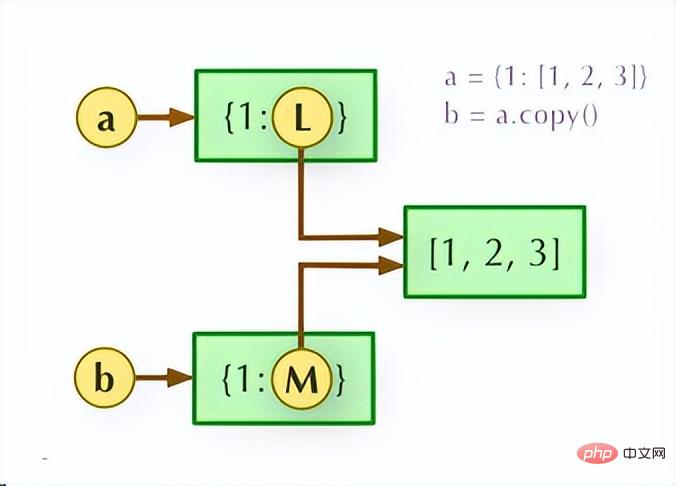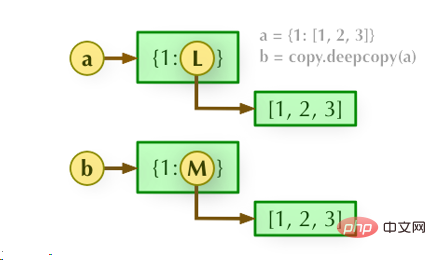 Backend Development
Backend Development
 Python Tutorial
Python Tutorial
 Frequent Python interview questions: shallow copy and deep copy
Frequent Python interview questions: shallow copy and deep copy
Frequent Python interview questions: shallow copy and deep copy

In Python interviews, shallow copy and deep copy are a relatively difficult question. Sixty percent of people have never heard of shallow copy and deep copy, and thirty percent of people only understand the basics of the two. The difference between concepts and simplicity. Only less than one adult can accurately tell the difference between the two and complete the writing of relevant code demos! Let us solve this difficulty today and add weight for promotion to the interview! This article may also be the most easy-to-understand article on the entire Internet that explains shallow copy and deep copy. As long as you follow the examples in the article and practice, you will definitely understand the technical difficulties of what shallow copy and deep copy are!
Variable assignment
In Python variable data types (lists, dictionaries, sets), assign a variable of a variable data type to another variable. The two variables refer to The same object has the same memory address. If one variable is modified, the other variable will be modified accordingly. If you want to know the technical details of mutable data types and immutable data types in Python, please read the article:Frequently asked questions in Python interviews: The difference between mutable data types and immutable data types.
Let’s take an example from my previous article.
l1=['a','b','c']
l2=l1
print(id(l1))
print(id(l2))
l2.append('d')
print("************")
print(id(l1))
print(l1)
print(id(l2))
print(l2)
输出:
838366483528
838366483528
************
838366483528
['a', 'b', 'c', 'd']
838366483528
['a', 'b', 'c', 'd']The output results will not be explained here. The addresses of l1 and l2 are the same, so they will affect each other.
Shallow copy
Copies the top level of an object and only copies the "reference" of the object.
Take an example from the previous article. There is only one layer in the list, that is, the element does not contain other lists.
l3=['x','y','z']
l4=list(l3)
print(id(l3))
print(id(l4))
l4.append('a')
print(l3)
print(l4)
输出
831456302152
831480344136
['x', 'y', 'z']
['x', 'y', 'z', 'a']As you can see from the results, the addresses of l3 and l4 are different, so they will not affect each other.
Let’s take another example and let the first element in l3 be a list.
l3=[['x','y','z'],'a','b']
l4=list(l3)
print(id(l3))
print(id(l4))
l4.append('c')
print(l3)
print(l4)
结果
533336249416
533337391240
[['x', 'y', 'z'], 'a', 'b']
[['x', 'y', 'z'], 'a', 'b', 'c']The result is exactly as expected, because the first element is a list, so it also has an address, and we print it.
print(id(l3[0])) print(id(l4[0])) 结果 533336248904 533336248904
We found that the addresses of l3[0] and l4[0] are actually the same, and then execute the following code.
l3[0].append('yy')
print(l3)
print(l4)
结果
[['x', 'y', 'z', 'yy'], 'a', 'b']
[['x', 'y', 'z', 'yy'], 'a', 'b', 'c']The results are in line with expectations, and modifying the value of l3[0] also affects l4[0]. So what can we do to prevent l3[0] and l4[0] from affecting each other? This requires the introduction of deep copies.
Deep copy
Deep copy copies each layer in the object. The copied object is completely independent from the original object and has no relationship. To implement deep copy, you need to use the deepcopy method in the copy module.
import copy
l3=[['x','y','z'],'a','b']
#l4=list(l3) #浅拷贝,使用=copy.copy(l3)也可以实现浅拷贝
l4=copy.deepcopy(l3) #深拷贝
l4.append('c')
print(id(l3[0]))
print(id(l4[0]))
l3[0].append('yy')
print(l3)
print(l4)
输出
407168435784
407166887304
[['x', 'y', 'z', 'yy'], 'a', 'b']
[['x', 'y', 'z'], 'a', 'b', 'c']You can see that l3[0] and l4[0] are completely independent and have no influence on each other.
Summary of shallow copy and deep copy
Not much to say, just use two pictures to give a simple explanation:
Shallow copy, as shown below:

Deep copy, as shown below:

The above is the detailed content of Frequent Python interview questions: shallow copy and deep copy. For more information, please follow other related articles on the PHP Chinese website!

Hot AI Tools

Undresser.AI Undress
AI-powered app for creating realistic nude photos

AI Clothes Remover
Online AI tool for removing clothes from photos.

Undress AI Tool
Undress images for free

Clothoff.io
AI clothes remover

AI Hentai Generator
Generate AI Hentai for free.

Hot Article

Hot Tools

Notepad++7.3.1
Easy-to-use and free code editor

SublimeText3 Chinese version
Chinese version, very easy to use

Zend Studio 13.0.1
Powerful PHP integrated development environment

Dreamweaver CS6
Visual web development tools

SublimeText3 Mac version
God-level code editing software (SublimeText3)

Hot Topics
 1378
1378
 52
52
 Python: Games, GUIs, and More
Apr 13, 2025 am 12:14 AM
Python: Games, GUIs, and More
Apr 13, 2025 am 12:14 AM
Python excels in gaming and GUI development. 1) Game development uses Pygame, providing drawing, audio and other functions, which are suitable for creating 2D games. 2) GUI development can choose Tkinter or PyQt. Tkinter is simple and easy to use, PyQt has rich functions and is suitable for professional development.
 PHP and Python: Comparing Two Popular Programming Languages
Apr 14, 2025 am 12:13 AM
PHP and Python: Comparing Two Popular Programming Languages
Apr 14, 2025 am 12:13 AM
PHP and Python each have their own advantages, and choose according to project requirements. 1.PHP is suitable for web development, especially for rapid development and maintenance of websites. 2. Python is suitable for data science, machine learning and artificial intelligence, with concise syntax and suitable for beginners.
 How debian readdir integrates with other tools
Apr 13, 2025 am 09:42 AM
How debian readdir integrates with other tools
Apr 13, 2025 am 09:42 AM
The readdir function in the Debian system is a system call used to read directory contents and is often used in C programming. This article will explain how to integrate readdir with other tools to enhance its functionality. Method 1: Combining C language program and pipeline First, write a C program to call the readdir function and output the result: #include#include#include#includeintmain(intargc,char*argv[]){DIR*dir;structdirent*entry;if(argc!=2){
 Python and Time: Making the Most of Your Study Time
Apr 14, 2025 am 12:02 AM
Python and Time: Making the Most of Your Study Time
Apr 14, 2025 am 12:02 AM
To maximize the efficiency of learning Python in a limited time, you can use Python's datetime, time, and schedule modules. 1. The datetime module is used to record and plan learning time. 2. The time module helps to set study and rest time. 3. The schedule module automatically arranges weekly learning tasks.
 Nginx SSL Certificate Update Debian Tutorial
Apr 13, 2025 am 07:21 AM
Nginx SSL Certificate Update Debian Tutorial
Apr 13, 2025 am 07:21 AM
This article will guide you on how to update your NginxSSL certificate on your Debian system. Step 1: Install Certbot First, make sure your system has certbot and python3-certbot-nginx packages installed. If not installed, please execute the following command: sudoapt-getupdatesudoapt-getinstallcertbotpython3-certbot-nginx Step 2: Obtain and configure the certificate Use the certbot command to obtain the Let'sEncrypt certificate and configure Nginx: sudocertbot--nginx Follow the prompts to select
 GitLab's plug-in development guide on Debian
Apr 13, 2025 am 08:24 AM
GitLab's plug-in development guide on Debian
Apr 13, 2025 am 08:24 AM
Developing a GitLab plugin on Debian requires some specific steps and knowledge. Here is a basic guide to help you get started with this process. Installing GitLab First, you need to install GitLab on your Debian system. You can refer to the official installation manual of GitLab. Get API access token Before performing API integration, you need to get GitLab's API access token first. Open the GitLab dashboard, find the "AccessTokens" option in the user settings, and generate a new access token. Will be generated
 How to configure HTTPS server in Debian OpenSSL
Apr 13, 2025 am 11:03 AM
How to configure HTTPS server in Debian OpenSSL
Apr 13, 2025 am 11:03 AM
Configuring an HTTPS server on a Debian system involves several steps, including installing the necessary software, generating an SSL certificate, and configuring a web server (such as Apache or Nginx) to use an SSL certificate. Here is a basic guide, assuming you are using an ApacheWeb server. 1. Install the necessary software First, make sure your system is up to date and install Apache and OpenSSL: sudoaptupdatesudoaptupgradesudoaptinsta
 What service is apache
Apr 13, 2025 pm 12:06 PM
What service is apache
Apr 13, 2025 pm 12:06 PM
Apache is the hero behind the Internet. It is not only a web server, but also a powerful platform that supports huge traffic and provides dynamic content. It provides extremely high flexibility through a modular design, allowing for the expansion of various functions as needed. However, modularity also presents configuration and performance challenges that require careful management. Apache is suitable for server scenarios that require highly customizable and meet complex needs.



